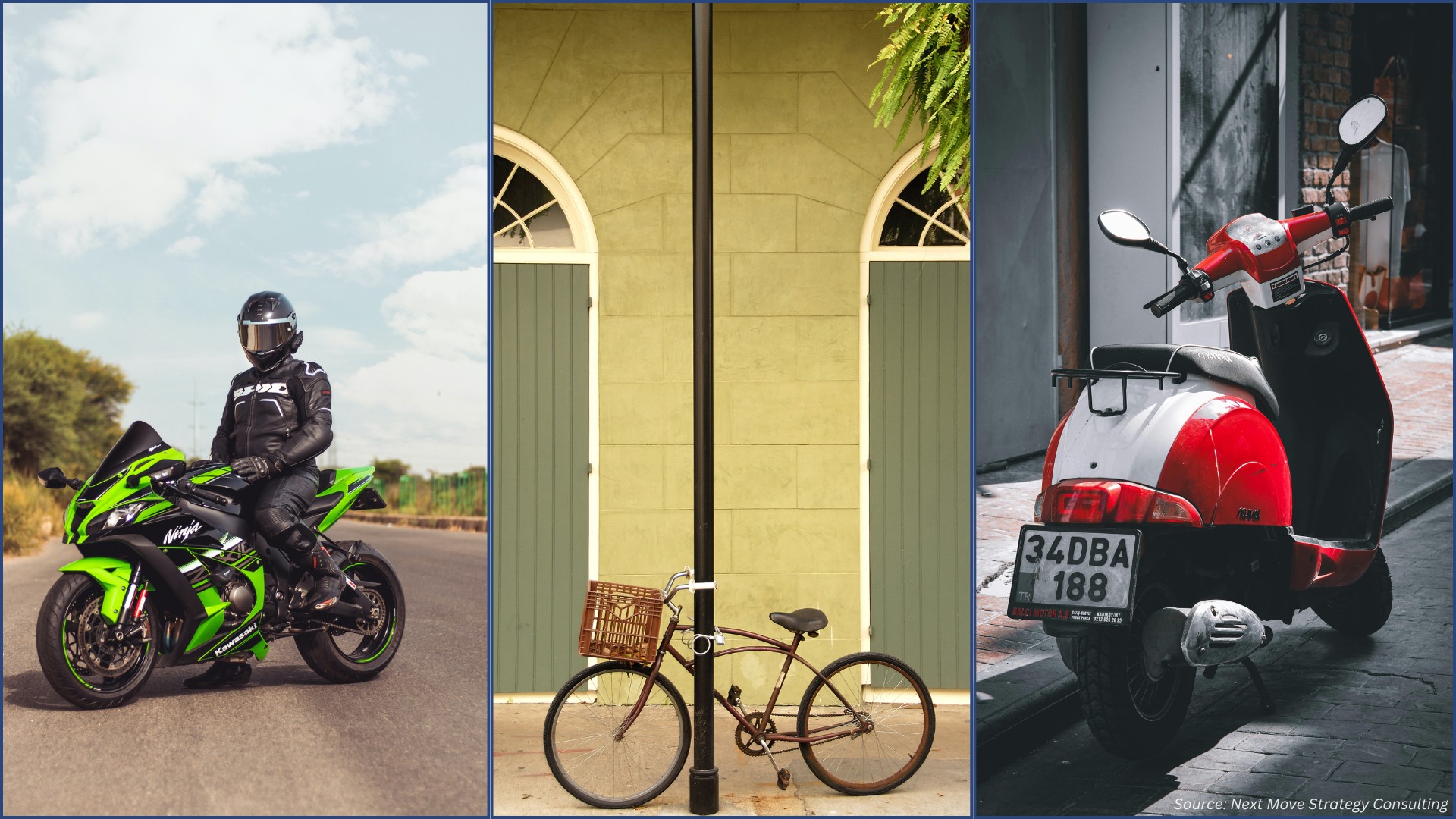GST 2.0 Slashes Prices, Boosts Two-Wheelers Market in 2025
Published: 2025-09-25

The Two-Wheelers Market is undergoing a transformative phase in 2025, driven by significant regulatory changes and shifting consumer preferences. The introduction of GST 2.0 in India, effective September 22, 2025, has reduced taxes on two-wheelers with engine capacities up to 350cc from 28% to 18%, making popular models more affordable and stimulating demand.
Two-Wheelers Market: Key Developments in 2024–2025
The most notable development in the two-wheelers market is the GST 2.0 reform in India, which has lowered the tax rate on two-wheelers up to 350cc, resulting in price reductions of up to 22,000 INR across major brands. Royal Enfield’s Classic 350, for instance, sees a price drop of approximately 16,500 INR, while the Hunter 350 and Meteor 350 benefit from reductions of up to 15,000 INR and 19,000 INR, respectively.
Similarly, Suzuki Motorcycle India has slashed prices by up to 18,024 INR, with the Gixxer SF 250 seeing the largest cut. Bajaj Auto and TVS Motor Company have also reduced prices by up to 20,000 INR and 22,000 INR, respectively, impacting models like the Bajaj Platina 110 and TVS Jupiter 125.
Another trend is the rising prominence of electric vehicles (EVs) in the two-wheeler segment, particularly in urban areas. Insurance claims data from Policybazaar indicates a 15% increase in claim volumes in 2024–2025, with EVs contributing 18%–20% more claims than petrol-powered bikes due to higher repair costs and rider unfamiliarity. This reflects growing EV adoption, though challenges like battery repair costs persist.
Applications Across Industries
The two-wheelers market serves diverse sectors beyond personal transportation:
-
Last-Mile Delivery: Scooters like the Suzuki Access 125 and TVS Jupiter 125 are widely used by e-commerce and food delivery platforms due to their affordability and maneuverability in urban traffic.
-
Commuter Mobility: Mid-segment motorcycles (150–350cc), such as the Royal Enfield Classic 350 and Honda CB 350, dominate urban and semi-urban commuting, offering cost-effective transport.
-
Leisure and Tourism: Premium models like the Royal Enfield Meteor 350 are popular for recreational riding, especially in markets with growing tourism sectors.
-
Shared Mobility: Two-wheelers are increasingly integrated into ride-sharing platforms, particularly in Asia-Pacific, enhancing urban mobility solutions.
These applications underscore the market’s role in supporting logistics, personal mobility, and lifestyle preferences, with GST 2.0 making these vehicles more accessible to businesses and consumers.
Analysis of Dominating and Fastest-Growing Regions
Dominating Region: Asia-Pacific
The Asia-Pacific region, particularly India, dominates the global two-wheelers market due to its large population, high urbanization rates, and affordability-driven demand. India alone accounts for a significant share of global two-wheeler sales, driven by models like the Bajaj Platina 110 and Hero HF Deluxe, which have become more affordable post-GST 2.0.
Top Countries:
-
India: Leads due to its vast consumer base and robust manufacturing ecosystem. The GST 2.0 reform has reduced prices by up to 22,000 INR, boosting demand for 150–350cc motorcycles and scooters, especially in urban centers like Maharashtra and Delhi, which account for nearly half of India’s two-wheeler insurance claims.
-
Indonesia: A key market due to heavy reliance on two-wheelers for commuting in congested cities like Jakarta. Local production by brands like Honda supports market dominance.
Why They Lead: India’s leadership stems from its price-sensitive market, where GST reductions directly translate to higher sales. Urbanization and rising middle-class incomes further fuel demand. Indonesia benefits from similar dynamics, with scooters dominating urban transport.
Fastest-Growing Region: Asia-Pacific (Emerging Markets)
Emerging markets within Asia-Pacific, such as Vietnam and Thailand, are the fastest-growing due to increasing disposable incomes and infrastructure development.
Top Countries:
-
Vietnam: Rapid urbanization and a growing middle class drive demand for affordable scooters and mid-segment motorcycles. Brands like Honda capitalize on this trend with localized offerings.
-
Thailand: Rising tourism and urban mobility needs boost two-wheeler sales, particularly for scooters used in ride-sharing and delivery services.
Why They Grow: These countries are experiencing rapid economic growth, increasing the affordability of two-wheelers. The adoption of EVs is also accelerating, supported by government incentives and urban infrastructure improvements.
Impact of GST 2.0 on the Two-Wheelers Market - Next Move Strategy Consulting's View
The GST 2.0 reform is a game-changer for the two-wheelers market, particularly in India, where it enhances affordability and stimulates demand. Price reductions of up to 22,000 INR for models like the Royal Enfield Classic 350 and TVS Jupiter 125 make mid-segment motorcycles and scooters more accessible to first-time buyers and small businesses.
Additionally, the rise in EV-related insurance claims highlights the need for manufacturers to address repair cost challenges to sustain EV growth. These changes will drive an increase in two-wheeler sales in India over 2025–2026, with EVs gaining a stronger foothold in urban markets.
Key Players and Recent Strategies
|
Company |
Recent Strategies |
|
Royal Enfield |
Passing full GST 2.0 benefits, reducing prices by up to 22,000 INR for 350cc models like Classic 350 and Hunter 350. Focus on affordability to target first-time buyers. |
|
Suzuki Motorcycle India |
Price cuts of up to 18,024 INR across scooters (e.g., Burgman Street EX) and motorcycles (e.g., Gixxer SF 250). Reduced spare parts costs to lower ownership expenses. |
|
Bajaj Auto |
Reduced prices by up to 20,000 INR for models like Platina 110 and KTM motorcycles, enhancing competitiveness in the commuter segment. |
|
TVS Motor Company |
Full GST benefit pass-through, with price cuts of up to 22,000 INR for models like Jupiter 125 and NTORQ 125, targeting urban commuters. |
|
Honda Motorcycle & Scooter India |
Price reductions of up to 18,887 INR for models like CB 350 and Dio 125, strengthening its position in the mid-segment market. |
|
Emerging: Ola Electric |
Expanding EV portfolio with affordable electric scooters, capitalizing on urban EV demand despite higher insurance claim costs. |
Leading players like Royal Enfield and TVS are leveraging GST 2.0 to enhance affordability, targeting price-sensitive consumers and small businesses. Suzuki’s focus on reducing spare parts costs addresses long-term ownership concerns, a critical factor for B2B buyers like delivery fleets. Emerging players like Ola Electric are innovating in the EV space, but face challenges with higher repair costs, necessitating robust after-sales strategies.
Future Prospects and Examples
The two-wheelers market is poised for growth through 2026, driven by affordability and EV adoption. In India, the GST 2.0 reform is expected to boost sales by 10%–12%, particularly for 150–350cc motorcycles and scooters used in last-mile delivery and commuting. The rise of EVs, despite higher insurance costs, points to a shift toward sustainable mobility.
Globally, emerging markets like Vietnam and Thailand will drive growth as urbanization and tourism increase demand for scooters and mid-segment bikes. However, manufacturers must address EV repair cost challenges and invest in rider education to sustain growth. Comprehensive insurance, as highlighted by Policybazaar, will also play a critical role in mitigating risks for businesses adopting two-wheelers for logistics.
About Next Move Strategy Consulting:
Next Move Strategy Consulting is a premier market research and management consulting firm that has been committed to provide strategically analysed well documented latest research reports to its clients. The research industry is flooded with many firms to choose from, what makes NextMSC different from the rest is its top-quality research and the obsession of turning data into knowledge by dissecting every bit of it and providing fact-based research recommendation that is supported by information collected from over 500 million websites, paid databases, industry journals and one on one consultations with industry experts across a diverse range of industry sectors. The high-quality customized research reports with actionable insights and excellent end-to-end customer service help our clients to take critical business decisions that enables them to move beyond time and have competitive edge in the industry.
We have been servicing over 1000 customers globally that includes 90% of the Fortune 500 companies over a decade. Our analysts are constantly tracking various high growth markets and identifying hidden opportunities in each sector or the industry. We provide one of the industry’s best quality syndicate as well as custom research reports across 10 different industry verticals. We are committed to deliver high quality research solutions in accordance to your business needs. Our industry standard delivery solutions that ranges from the pre consultation to after-sales services, provide an excellent client experience and ensure right strategic decision making for businesses.
For more information, please contact:
Next Move Strategy Consulting
5th Floor 867
Boylston St, STE 500,
Boston, MA 02116, U.S.
E-Mail: [email protected]
Direct: +18577585017
Website: www.nextmsc.com
About the Author
 Sneha Chakraborty, a skilled SEO Executive and Content Writer with over 4 years in digital marketing, excels in boosting online visibility and engagement with data-driven strategies and compelling content. Passionate about simplifying digital ideas, she enjoys reading, sketching, and nature photography
Sneha Chakraborty, a skilled SEO Executive and Content Writer with over 4 years in digital marketing, excels in boosting online visibility and engagement with data-driven strategies and compelling content. Passionate about simplifying digital ideas, she enjoys reading, sketching, and nature photography
About the Reviewer
 Sanyukta Deb is a skilled Content Writer and Digital Marketing Team Leader, specializing in online visibility strategies and data-driven campaigns. She excels at creating audience-focused content that boosts brand presence and engagement, while also pursuing creative projects and design interests
Sanyukta Deb is a skilled Content Writer and Digital Marketing Team Leader, specializing in online visibility strategies and data-driven campaigns. She excels at creating audience-focused content that boosts brand presence and engagement, while also pursuing creative projects and design interests
















Add Comment